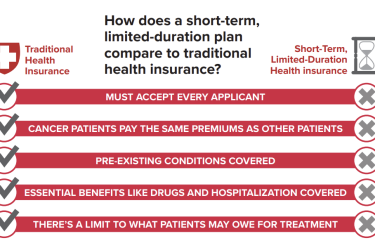
A report released today by the National Center for Health Statistics indicates that the uninsured rate among Americans of all ages was 8.8 percent in the third quarter of 2016.
The report shows that in the first nine months of last year, 28.2 million Americans remained uninsured, and this number was 20.4 million fewer than those uninsured in 2010, the year Congress passed the Affordable Care Act (ACA).
However, the number counted were 400,000 fewer than the 28.6 million Americans who were uninsured in 2015, a difference that NCHS said was not significant. The figures for this report come from the National Health Insurance Interview Survey.
A separate Gallup report released Feb. 8 said six states had reduced the uninsured rate by 10 percentage points or more, and in no state had the uninsured rate risen since 2013. (Remember that the ACA became effective in 2014.) Not surprisingly, the states that expanded their Medicaid programs under the act experienced the largest reductions in the uninsured rate, Gallup said. The rate of uninsured Americans dropped nationwide from 17.3 percent in 2013 to 10.9 percent in the fourth quarter of 2016, Gallup reported. The source of the Gallup data is the Gallup-Healthways Well-Being Index.
These two reports are significant because the success of any plan that Congress and the Trump administration implement to replace the ACA will be measured against these numbers and any subsequent reports on the uninsured rate. The NCHS data are useful because the report estimates rates of public and private insurance coverage and coverage through the ACA’s Marketplace exchanges. It also offers valuable data on the enrollment in high-deductible health plans (HDHPs) and consumer-directed health plans (CDHPs). A CDHP is an HDHP with a health savings account (HSA).
Since 2010, enrollment in HDHPs and CDHPs has risen steadily, from about a quarter of all Americans under age 65 to almost 40 percent today. In 2010, 25.3 percent of Americans under age 65 were enrolled in these plans, including 17.6 percent of the population in HDHPs and 7.7 percent in CDHPs, the report showed. Through Sept. 30, 2016, 39.1 percent of Americans under age 65 were enrolled either in an HDHP (24.0 percent) or a CDHP (15.2 percent). (Note that the numbers do not add up to the total due to rounding, NCHS said.) Enrollment in these plans has grown as employers have shifted costs to workers and their families.
The report shows uninsurance rate trends by age, poverty status, race and ethnicity. In the first nine months of 2016, for example, the uninsured rate among adults age 18 to 24 was 13.6 percent. It was 16.4 percent among those 25-to-34 years and 14.7 percent among those 35-to-44 years. The uninsured rate was lowest among those 45-to-64 years at 8.6 percent.








